Strategic Management Plan: Evaluating Zara's Growth & Objectives
VerifiedAdded on 2023/06/11
|13
|3936
|150
Report
AI Summary
This report provides a strategic management analysis of Zara, a successful fashion retailer, focusing on its business environment, resource capabilities, and strategies for sustainable growth. It includes SWOT, PESTEL, and VRIO analyses to evaluate Zara's strengths, weaknesses, opportunities, and threats, as well as its competitive environment using Porter's Five Forces model. The report identifies Zara's competitive advantages, such as its quick access to fashion trends and unique designs, and suggests tactics to achieve strategic objectives, including enhancing product quality, improving online presence, and promoting sustainability. It also explores strategic direction choices, such as cost leadership and differentiation, and recommends growth strategies for Zara to maintain its market dominance. The report concludes by suggesting ways to monitor the effectiveness of implemented strategies to ensure long-term success.
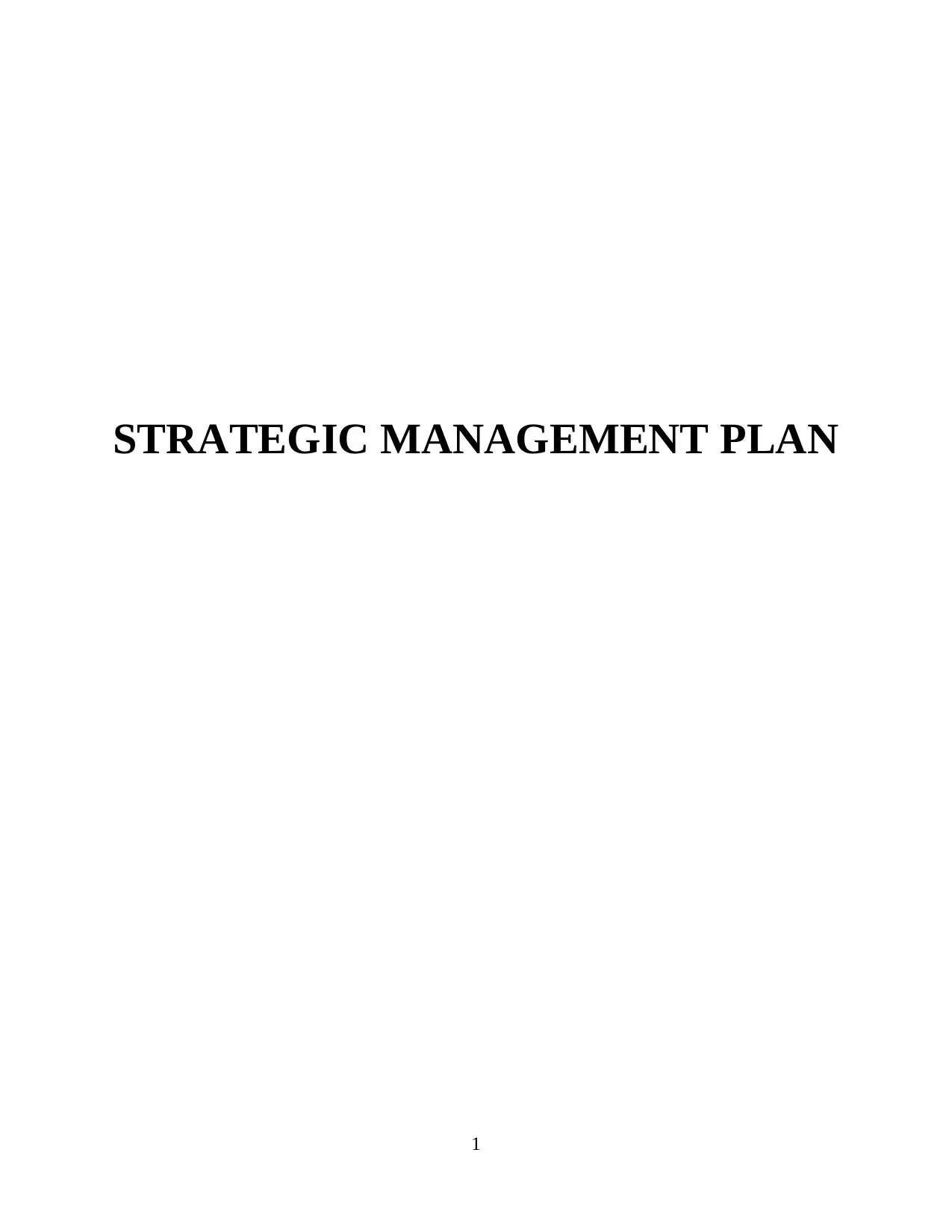
STRATEGIC MANAGEMENT PLAN
1
1
Paraphrase This Document
Need a fresh take? Get an instant paraphrase of this document with our AI Paraphraser
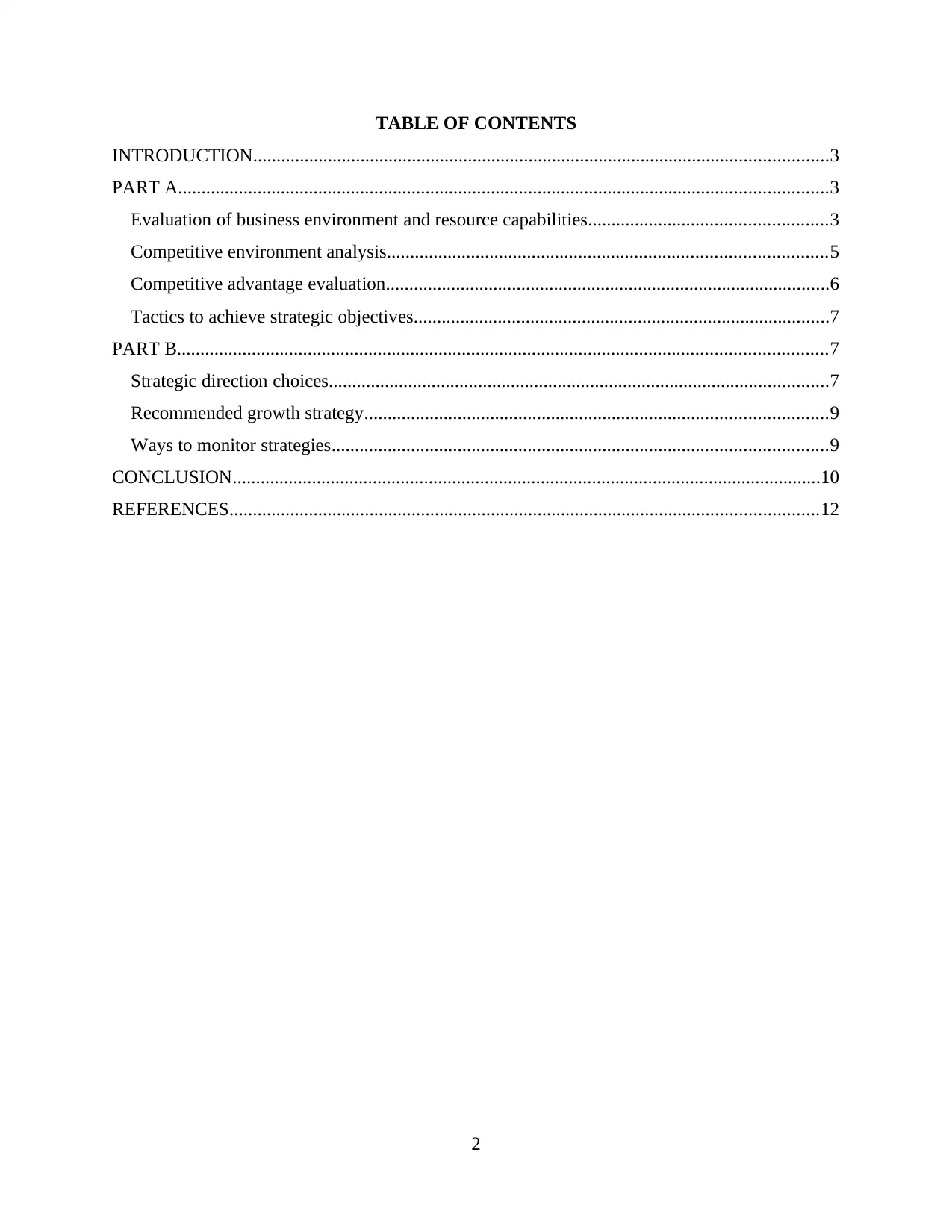
TABLE OF CONTENTS
INTRODUCTION...........................................................................................................................3
PART A...........................................................................................................................................3
Evaluation of business environment and resource capabilities...................................................3
Competitive environment analysis..............................................................................................5
Competitive advantage evaluation...............................................................................................6
Tactics to achieve strategic objectives.........................................................................................7
PART B...........................................................................................................................................7
Strategic direction choices...........................................................................................................7
Recommended growth strategy...................................................................................................9
Ways to monitor strategies..........................................................................................................9
CONCLUSION..............................................................................................................................10
REFERENCES..............................................................................................................................12
2
INTRODUCTION...........................................................................................................................3
PART A...........................................................................................................................................3
Evaluation of business environment and resource capabilities...................................................3
Competitive environment analysis..............................................................................................5
Competitive advantage evaluation...............................................................................................6
Tactics to achieve strategic objectives.........................................................................................7
PART B...........................................................................................................................................7
Strategic direction choices...........................................................................................................7
Recommended growth strategy...................................................................................................9
Ways to monitor strategies..........................................................................................................9
CONCLUSION..............................................................................................................................10
REFERENCES..............................................................................................................................12
2
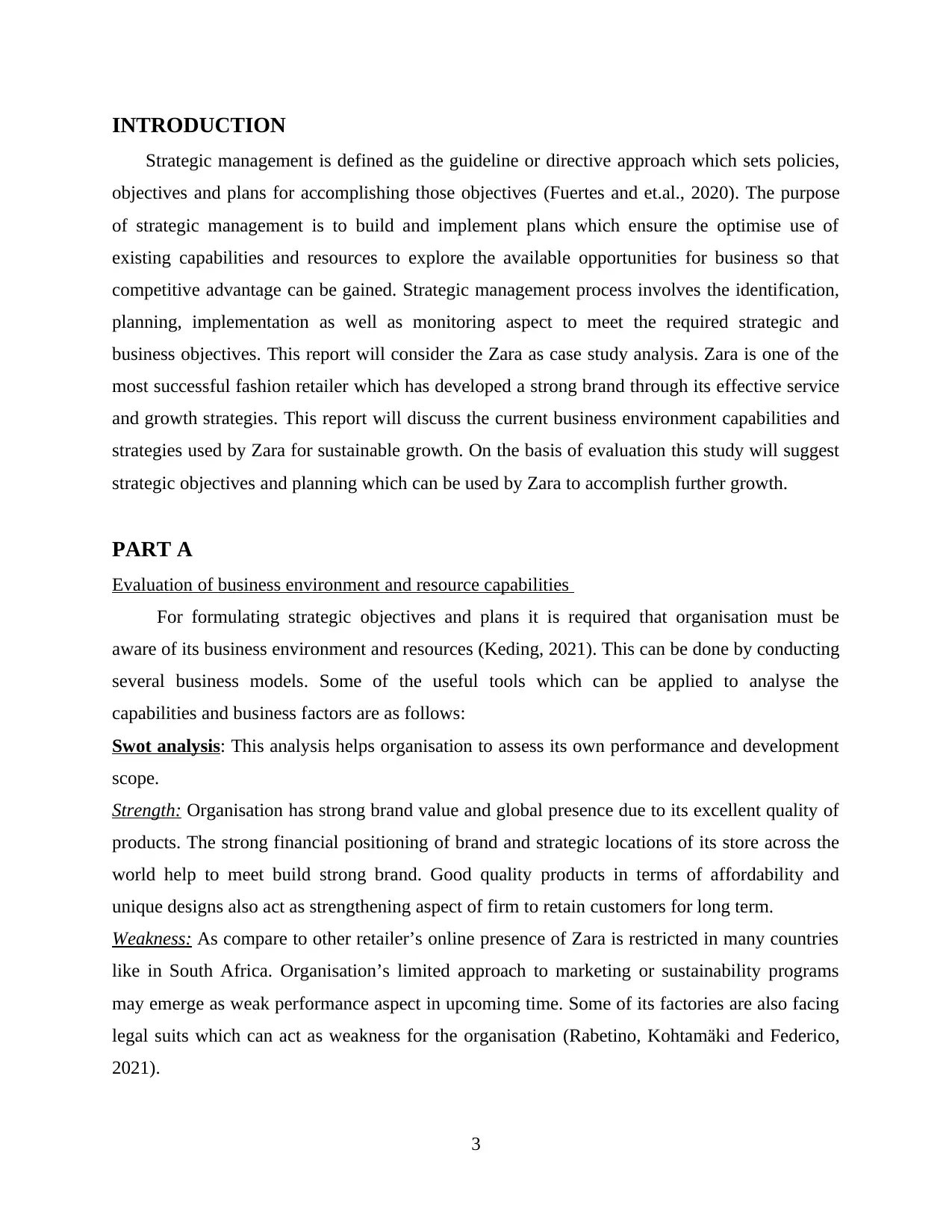
INTRODUCTION
Strategic management is defined as the guideline or directive approach which sets policies,
objectives and plans for accomplishing those objectives (Fuertes and et.al., 2020). The purpose
of strategic management is to build and implement plans which ensure the optimise use of
existing capabilities and resources to explore the available opportunities for business so that
competitive advantage can be gained. Strategic management process involves the identification,
planning, implementation as well as monitoring aspect to meet the required strategic and
business objectives. This report will consider the Zara as case study analysis. Zara is one of the
most successful fashion retailer which has developed a strong brand through its effective service
and growth strategies. This report will discuss the current business environment capabilities and
strategies used by Zara for sustainable growth. On the basis of evaluation this study will suggest
strategic objectives and planning which can be used by Zara to accomplish further growth.
PART A
Evaluation of business environment and resource capabilities
For formulating strategic objectives and plans it is required that organisation must be
aware of its business environment and resources (Keding, 2021). This can be done by conducting
several business models. Some of the useful tools which can be applied to analyse the
capabilities and business factors are as follows:
Swot analysis: This analysis helps organisation to assess its own performance and development
scope.
Strength: Organisation has strong brand value and global presence due to its excellent quality of
products. The strong financial positioning of brand and strategic locations of its store across the
world help to meet build strong brand. Good quality products in terms of affordability and
unique designs also act as strengthening aspect of firm to retain customers for long term.
Weakness: As compare to other retailer’s online presence of Zara is restricted in many countries
like in South Africa. Organisation’s limited approach to marketing or sustainability programs
may emerge as weak performance aspect in upcoming time. Some of its factories are also facing
legal suits which can act as weakness for the organisation (Rabetino, Kohtamäki and Federico,
2021).
3
Strategic management is defined as the guideline or directive approach which sets policies,
objectives and plans for accomplishing those objectives (Fuertes and et.al., 2020). The purpose
of strategic management is to build and implement plans which ensure the optimise use of
existing capabilities and resources to explore the available opportunities for business so that
competitive advantage can be gained. Strategic management process involves the identification,
planning, implementation as well as monitoring aspect to meet the required strategic and
business objectives. This report will consider the Zara as case study analysis. Zara is one of the
most successful fashion retailer which has developed a strong brand through its effective service
and growth strategies. This report will discuss the current business environment capabilities and
strategies used by Zara for sustainable growth. On the basis of evaluation this study will suggest
strategic objectives and planning which can be used by Zara to accomplish further growth.
PART A
Evaluation of business environment and resource capabilities
For formulating strategic objectives and plans it is required that organisation must be
aware of its business environment and resources (Keding, 2021). This can be done by conducting
several business models. Some of the useful tools which can be applied to analyse the
capabilities and business factors are as follows:
Swot analysis: This analysis helps organisation to assess its own performance and development
scope.
Strength: Organisation has strong brand value and global presence due to its excellent quality of
products. The strong financial positioning of brand and strategic locations of its store across the
world help to meet build strong brand. Good quality products in terms of affordability and
unique designs also act as strengthening aspect of firm to retain customers for long term.
Weakness: As compare to other retailer’s online presence of Zara is restricted in many countries
like in South Africa. Organisation’s limited approach to marketing or sustainability programs
may emerge as weak performance aspect in upcoming time. Some of its factories are also facing
legal suits which can act as weakness for the organisation (Rabetino, Kohtamäki and Federico,
2021).
3
⊘ This is a preview!⊘
Do you want full access?
Subscribe today to unlock all pages.

Trusted by 1+ million students worldwide
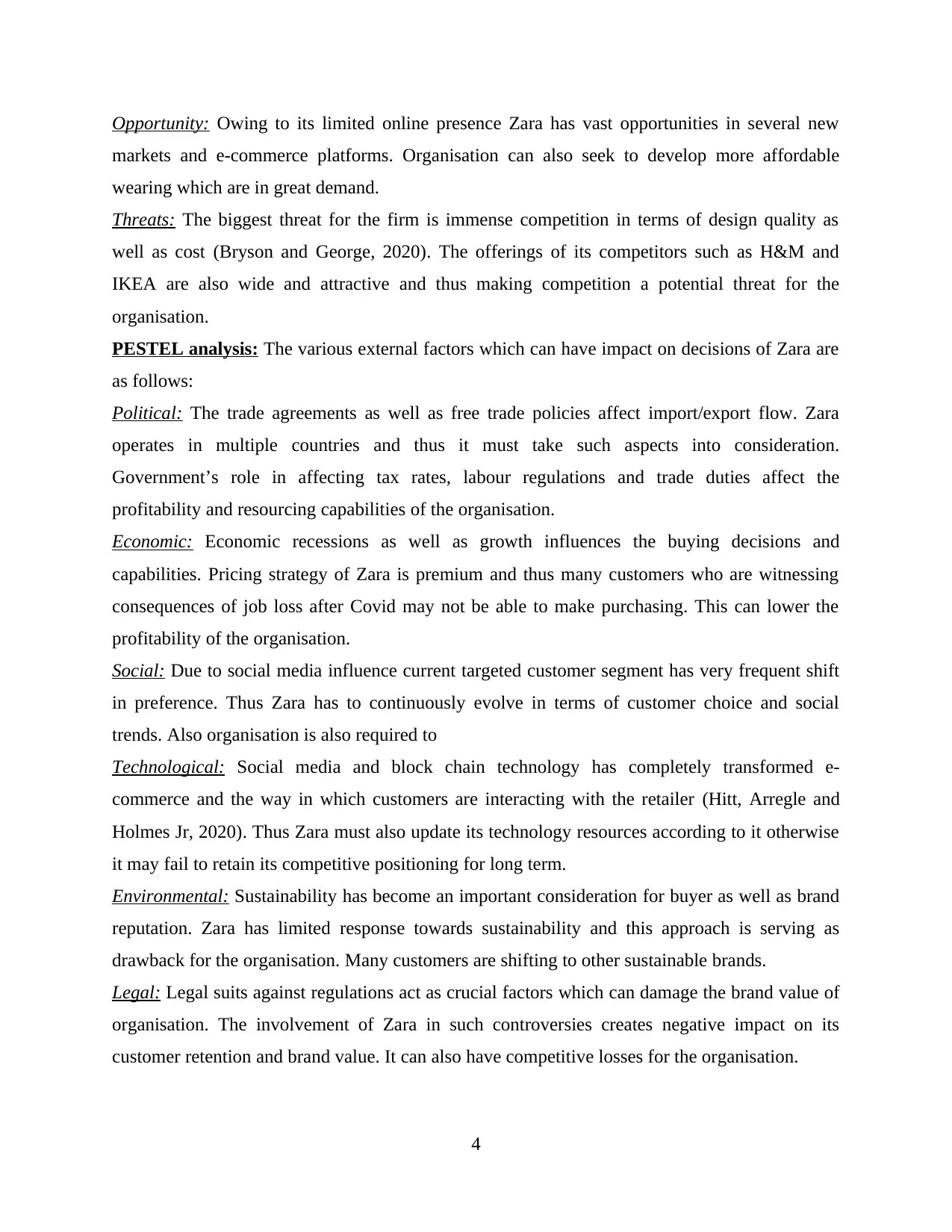
Opportunity: Owing to its limited online presence Zara has vast opportunities in several new
markets and e-commerce platforms. Organisation can also seek to develop more affordable
wearing which are in great demand.
Threats: The biggest threat for the firm is immense competition in terms of design quality as
well as cost (Bryson and George, 2020). The offerings of its competitors such as H&M and
IKEA are also wide and attractive and thus making competition a potential threat for the
organisation.
PESTEL analysis: The various external factors which can have impact on decisions of Zara are
as follows:
Political: The trade agreements as well as free trade policies affect import/export flow. Zara
operates in multiple countries and thus it must take such aspects into consideration.
Government’s role in affecting tax rates, labour regulations and trade duties affect the
profitability and resourcing capabilities of the organisation.
Economic: Economic recessions as well as growth influences the buying decisions and
capabilities. Pricing strategy of Zara is premium and thus many customers who are witnessing
consequences of job loss after Covid may not be able to make purchasing. This can lower the
profitability of the organisation.
Social: Due to social media influence current targeted customer segment has very frequent shift
in preference. Thus Zara has to continuously evolve in terms of customer choice and social
trends. Also organisation is also required to
Technological: Social media and block chain technology has completely transformed e-
commerce and the way in which customers are interacting with the retailer (Hitt, Arregle and
Holmes Jr, 2020). Thus Zara must also update its technology resources according to it otherwise
it may fail to retain its competitive positioning for long term.
Environmental: Sustainability has become an important consideration for buyer as well as brand
reputation. Zara has limited response towards sustainability and this approach is serving as
drawback for the organisation. Many customers are shifting to other sustainable brands.
Legal: Legal suits against regulations act as crucial factors which can damage the brand value of
organisation. The involvement of Zara in such controversies creates negative impact on its
customer retention and brand value. It can also have competitive losses for the organisation.
4
markets and e-commerce platforms. Organisation can also seek to develop more affordable
wearing which are in great demand.
Threats: The biggest threat for the firm is immense competition in terms of design quality as
well as cost (Bryson and George, 2020). The offerings of its competitors such as H&M and
IKEA are also wide and attractive and thus making competition a potential threat for the
organisation.
PESTEL analysis: The various external factors which can have impact on decisions of Zara are
as follows:
Political: The trade agreements as well as free trade policies affect import/export flow. Zara
operates in multiple countries and thus it must take such aspects into consideration.
Government’s role in affecting tax rates, labour regulations and trade duties affect the
profitability and resourcing capabilities of the organisation.
Economic: Economic recessions as well as growth influences the buying decisions and
capabilities. Pricing strategy of Zara is premium and thus many customers who are witnessing
consequences of job loss after Covid may not be able to make purchasing. This can lower the
profitability of the organisation.
Social: Due to social media influence current targeted customer segment has very frequent shift
in preference. Thus Zara has to continuously evolve in terms of customer choice and social
trends. Also organisation is also required to
Technological: Social media and block chain technology has completely transformed e-
commerce and the way in which customers are interacting with the retailer (Hitt, Arregle and
Holmes Jr, 2020). Thus Zara must also update its technology resources according to it otherwise
it may fail to retain its competitive positioning for long term.
Environmental: Sustainability has become an important consideration for buyer as well as brand
reputation. Zara has limited response towards sustainability and this approach is serving as
drawback for the organisation. Many customers are shifting to other sustainable brands.
Legal: Legal suits against regulations act as crucial factors which can damage the brand value of
organisation. The involvement of Zara in such controversies creates negative impact on its
customer retention and brand value. It can also have competitive losses for the organisation.
4
Paraphrase This Document
Need a fresh take? Get an instant paraphrase of this document with our AI Paraphraser
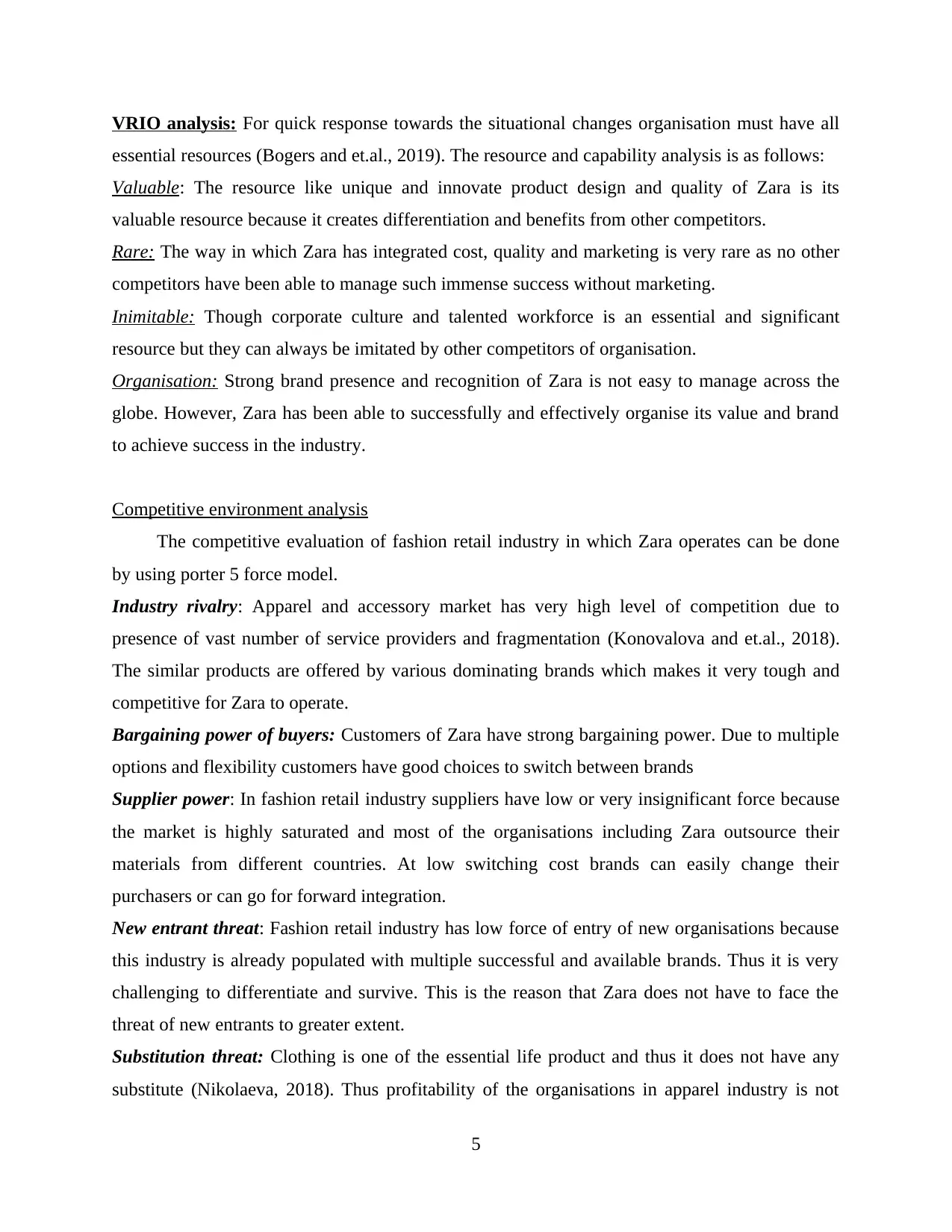
VRIO analysis: For quick response towards the situational changes organisation must have all
essential resources (Bogers and et.al., 2019). The resource and capability analysis is as follows:
Valuable: The resource like unique and innovate product design and quality of Zara is its
valuable resource because it creates differentiation and benefits from other competitors.
Rare: The way in which Zara has integrated cost, quality and marketing is very rare as no other
competitors have been able to manage such immense success without marketing.
Inimitable: Though corporate culture and talented workforce is an essential and significant
resource but they can always be imitated by other competitors of organisation.
Organisation: Strong brand presence and recognition of Zara is not easy to manage across the
globe. However, Zara has been able to successfully and effectively organise its value and brand
to achieve success in the industry.
Competitive environment analysis
The competitive evaluation of fashion retail industry in which Zara operates can be done
by using porter 5 force model.
Industry rivalry: Apparel and accessory market has very high level of competition due to
presence of vast number of service providers and fragmentation (Konovalova and et.al., 2018).
The similar products are offered by various dominating brands which makes it very tough and
competitive for Zara to operate.
Bargaining power of buyers: Customers of Zara have strong bargaining power. Due to multiple
options and flexibility customers have good choices to switch between brands
Supplier power: In fashion retail industry suppliers have low or very insignificant force because
the market is highly saturated and most of the organisations including Zara outsource their
materials from different countries. At low switching cost brands can easily change their
purchasers or can go for forward integration.
New entrant threat: Fashion retail industry has low force of entry of new organisations because
this industry is already populated with multiple successful and available brands. Thus it is very
challenging to differentiate and survive. This is the reason that Zara does not have to face the
threat of new entrants to greater extent.
Substitution threat: Clothing is one of the essential life product and thus it does not have any
substitute (Nikolaeva, 2018). Thus profitability of the organisations in apparel industry is not
5
essential resources (Bogers and et.al., 2019). The resource and capability analysis is as follows:
Valuable: The resource like unique and innovate product design and quality of Zara is its
valuable resource because it creates differentiation and benefits from other competitors.
Rare: The way in which Zara has integrated cost, quality and marketing is very rare as no other
competitors have been able to manage such immense success without marketing.
Inimitable: Though corporate culture and talented workforce is an essential and significant
resource but they can always be imitated by other competitors of organisation.
Organisation: Strong brand presence and recognition of Zara is not easy to manage across the
globe. However, Zara has been able to successfully and effectively organise its value and brand
to achieve success in the industry.
Competitive environment analysis
The competitive evaluation of fashion retail industry in which Zara operates can be done
by using porter 5 force model.
Industry rivalry: Apparel and accessory market has very high level of competition due to
presence of vast number of service providers and fragmentation (Konovalova and et.al., 2018).
The similar products are offered by various dominating brands which makes it very tough and
competitive for Zara to operate.
Bargaining power of buyers: Customers of Zara have strong bargaining power. Due to multiple
options and flexibility customers have good choices to switch between brands
Supplier power: In fashion retail industry suppliers have low or very insignificant force because
the market is highly saturated and most of the organisations including Zara outsource their
materials from different countries. At low switching cost brands can easily change their
purchasers or can go for forward integration.
New entrant threat: Fashion retail industry has low force of entry of new organisations because
this industry is already populated with multiple successful and available brands. Thus it is very
challenging to differentiate and survive. This is the reason that Zara does not have to face the
threat of new entrants to greater extent.
Substitution threat: Clothing is one of the essential life product and thus it does not have any
substitute (Nikolaeva, 2018). Thus profitability of the organisations in apparel industry is not
5
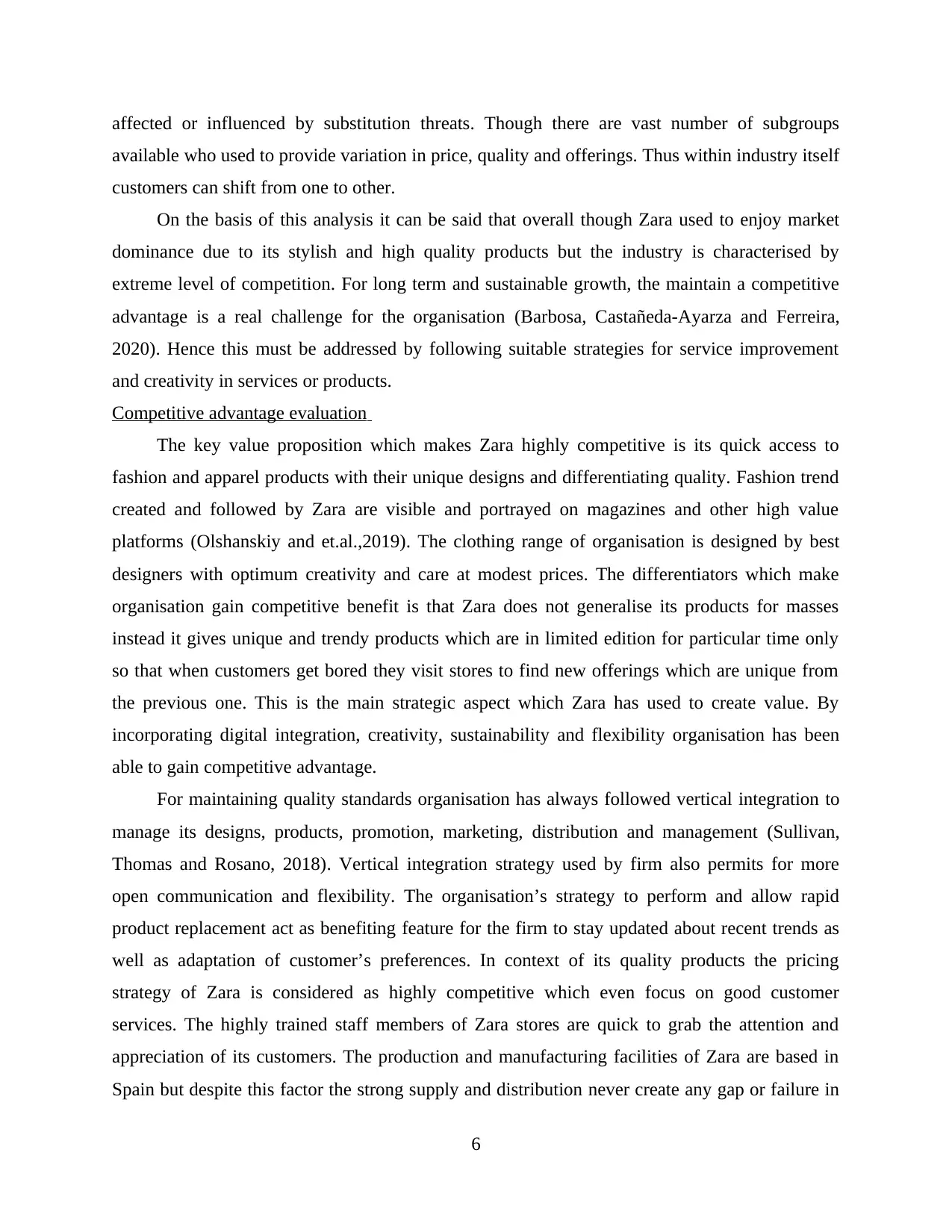
affected or influenced by substitution threats. Though there are vast number of subgroups
available who used to provide variation in price, quality and offerings. Thus within industry itself
customers can shift from one to other.
On the basis of this analysis it can be said that overall though Zara used to enjoy market
dominance due to its stylish and high quality products but the industry is characterised by
extreme level of competition. For long term and sustainable growth, the maintain a competitive
advantage is a real challenge for the organisation (Barbosa, Castañeda-Ayarza and Ferreira,
2020). Hence this must be addressed by following suitable strategies for service improvement
and creativity in services or products.
Competitive advantage evaluation
The key value proposition which makes Zara highly competitive is its quick access to
fashion and apparel products with their unique designs and differentiating quality. Fashion trend
created and followed by Zara are visible and portrayed on magazines and other high value
platforms (Olshanskiy and et.al.,2019). The clothing range of organisation is designed by best
designers with optimum creativity and care at modest prices. The differentiators which make
organisation gain competitive benefit is that Zara does not generalise its products for masses
instead it gives unique and trendy products which are in limited edition for particular time only
so that when customers get bored they visit stores to find new offerings which are unique from
the previous one. This is the main strategic aspect which Zara has used to create value. By
incorporating digital integration, creativity, sustainability and flexibility organisation has been
able to gain competitive advantage.
For maintaining quality standards organisation has always followed vertical integration to
manage its designs, products, promotion, marketing, distribution and management (Sullivan,
Thomas and Rosano, 2018). Vertical integration strategy used by firm also permits for more
open communication and flexibility. The organisation’s strategy to perform and allow rapid
product replacement act as benefiting feature for the firm to stay updated about recent trends as
well as adaptation of customer’s preferences. In context of its quality products the pricing
strategy of Zara is considered as highly competitive which even focus on good customer
services. The highly trained staff members of Zara stores are quick to grab the attention and
appreciation of its customers. The production and manufacturing facilities of Zara are based in
Spain but despite this factor the strong supply and distribution never create any gap or failure in
6
available who used to provide variation in price, quality and offerings. Thus within industry itself
customers can shift from one to other.
On the basis of this analysis it can be said that overall though Zara used to enjoy market
dominance due to its stylish and high quality products but the industry is characterised by
extreme level of competition. For long term and sustainable growth, the maintain a competitive
advantage is a real challenge for the organisation (Barbosa, Castañeda-Ayarza and Ferreira,
2020). Hence this must be addressed by following suitable strategies for service improvement
and creativity in services or products.
Competitive advantage evaluation
The key value proposition which makes Zara highly competitive is its quick access to
fashion and apparel products with their unique designs and differentiating quality. Fashion trend
created and followed by Zara are visible and portrayed on magazines and other high value
platforms (Olshanskiy and et.al.,2019). The clothing range of organisation is designed by best
designers with optimum creativity and care at modest prices. The differentiators which make
organisation gain competitive benefit is that Zara does not generalise its products for masses
instead it gives unique and trendy products which are in limited edition for particular time only
so that when customers get bored they visit stores to find new offerings which are unique from
the previous one. This is the main strategic aspect which Zara has used to create value. By
incorporating digital integration, creativity, sustainability and flexibility organisation has been
able to gain competitive advantage.
For maintaining quality standards organisation has always followed vertical integration to
manage its designs, products, promotion, marketing, distribution and management (Sullivan,
Thomas and Rosano, 2018). Vertical integration strategy used by firm also permits for more
open communication and flexibility. The organisation’s strategy to perform and allow rapid
product replacement act as benefiting feature for the firm to stay updated about recent trends as
well as adaptation of customer’s preferences. In context of its quality products the pricing
strategy of Zara is considered as highly competitive which even focus on good customer
services. The highly trained staff members of Zara stores are quick to grab the attention and
appreciation of its customers. The production and manufacturing facilities of Zara are based in
Spain but despite this factor the strong supply and distribution never create any gap or failure in
6
⊘ This is a preview!⊘
Do you want full access?
Subscribe today to unlock all pages.

Trusted by 1+ million students worldwide
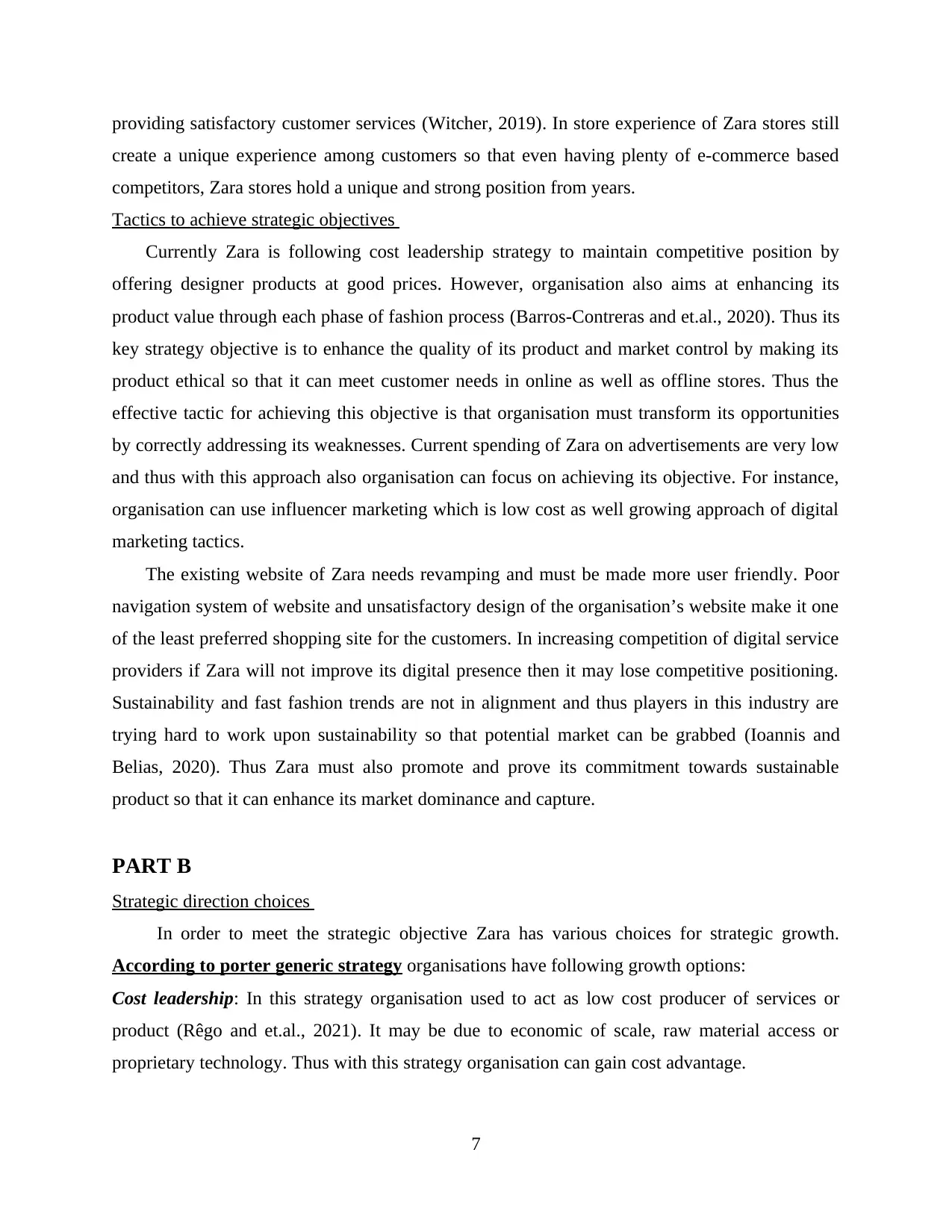
providing satisfactory customer services (Witcher, 2019). In store experience of Zara stores still
create a unique experience among customers so that even having plenty of e-commerce based
competitors, Zara stores hold a unique and strong position from years.
Tactics to achieve strategic objectives
Currently Zara is following cost leadership strategy to maintain competitive position by
offering designer products at good prices. However, organisation also aims at enhancing its
product value through each phase of fashion process (Barros-Contreras and et.al., 2020). Thus its
key strategy objective is to enhance the quality of its product and market control by making its
product ethical so that it can meet customer needs in online as well as offline stores. Thus the
effective tactic for achieving this objective is that organisation must transform its opportunities
by correctly addressing its weaknesses. Current spending of Zara on advertisements are very low
and thus with this approach also organisation can focus on achieving its objective. For instance,
organisation can use influencer marketing which is low cost as well growing approach of digital
marketing tactics.
The existing website of Zara needs revamping and must be made more user friendly. Poor
navigation system of website and unsatisfactory design of the organisation’s website make it one
of the least preferred shopping site for the customers. In increasing competition of digital service
providers if Zara will not improve its digital presence then it may lose competitive positioning.
Sustainability and fast fashion trends are not in alignment and thus players in this industry are
trying hard to work upon sustainability so that potential market can be grabbed (Ioannis and
Belias, 2020). Thus Zara must also promote and prove its commitment towards sustainable
product so that it can enhance its market dominance and capture.
PART B
Strategic direction choices
In order to meet the strategic objective Zara has various choices for strategic growth.
According to porter generic strategy organisations have following growth options:
Cost leadership: In this strategy organisation used to act as low cost producer of services or
product (Rêgo and et.al., 2021). It may be due to economic of scale, raw material access or
proprietary technology. Thus with this strategy organisation can gain cost advantage.
7
create a unique experience among customers so that even having plenty of e-commerce based
competitors, Zara stores hold a unique and strong position from years.
Tactics to achieve strategic objectives
Currently Zara is following cost leadership strategy to maintain competitive position by
offering designer products at good prices. However, organisation also aims at enhancing its
product value through each phase of fashion process (Barros-Contreras and et.al., 2020). Thus its
key strategy objective is to enhance the quality of its product and market control by making its
product ethical so that it can meet customer needs in online as well as offline stores. Thus the
effective tactic for achieving this objective is that organisation must transform its opportunities
by correctly addressing its weaknesses. Current spending of Zara on advertisements are very low
and thus with this approach also organisation can focus on achieving its objective. For instance,
organisation can use influencer marketing which is low cost as well growing approach of digital
marketing tactics.
The existing website of Zara needs revamping and must be made more user friendly. Poor
navigation system of website and unsatisfactory design of the organisation’s website make it one
of the least preferred shopping site for the customers. In increasing competition of digital service
providers if Zara will not improve its digital presence then it may lose competitive positioning.
Sustainability and fast fashion trends are not in alignment and thus players in this industry are
trying hard to work upon sustainability so that potential market can be grabbed (Ioannis and
Belias, 2020). Thus Zara must also promote and prove its commitment towards sustainable
product so that it can enhance its market dominance and capture.
PART B
Strategic direction choices
In order to meet the strategic objective Zara has various choices for strategic growth.
According to porter generic strategy organisations have following growth options:
Cost leadership: In this strategy organisation used to act as low cost producer of services or
product (Rêgo and et.al., 2021). It may be due to economic of scale, raw material access or
proprietary technology. Thus with this strategy organisation can gain cost advantage.
7
Paraphrase This Document
Need a fresh take? Get an instant paraphrase of this document with our AI Paraphraser
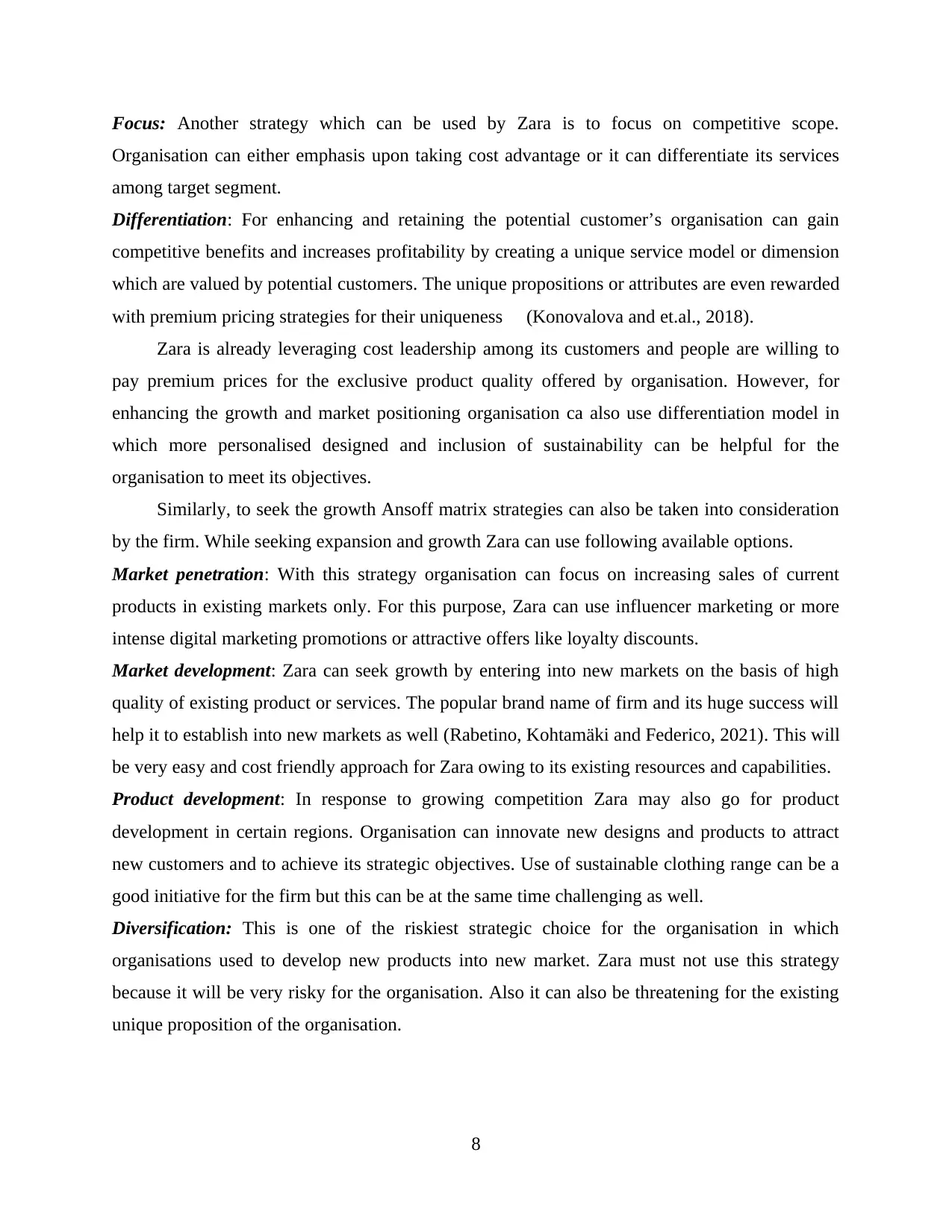
Focus: Another strategy which can be used by Zara is to focus on competitive scope.
Organisation can either emphasis upon taking cost advantage or it can differentiate its services
among target segment.
Differentiation: For enhancing and retaining the potential customer’s organisation can gain
competitive benefits and increases profitability by creating a unique service model or dimension
which are valued by potential customers. The unique propositions or attributes are even rewarded
with premium pricing strategies for their uniqueness (Konovalova and et.al., 2018).
Zara is already leveraging cost leadership among its customers and people are willing to
pay premium prices for the exclusive product quality offered by organisation. However, for
enhancing the growth and market positioning organisation ca also use differentiation model in
which more personalised designed and inclusion of sustainability can be helpful for the
organisation to meet its objectives.
Similarly, to seek the growth Ansoff matrix strategies can also be taken into consideration
by the firm. While seeking expansion and growth Zara can use following available options.
Market penetration: With this strategy organisation can focus on increasing sales of current
products in existing markets only. For this purpose, Zara can use influencer marketing or more
intense digital marketing promotions or attractive offers like loyalty discounts.
Market development: Zara can seek growth by entering into new markets on the basis of high
quality of existing product or services. The popular brand name of firm and its huge success will
help it to establish into new markets as well (Rabetino, Kohtamäki and Federico, 2021). This will
be very easy and cost friendly approach for Zara owing to its existing resources and capabilities.
Product development: In response to growing competition Zara may also go for product
development in certain regions. Organisation can innovate new designs and products to attract
new customers and to achieve its strategic objectives. Use of sustainable clothing range can be a
good initiative for the firm but this can be at the same time challenging as well.
Diversification: This is one of the riskiest strategic choice for the organisation in which
organisations used to develop new products into new market. Zara must not use this strategy
because it will be very risky for the organisation. Also it can also be threatening for the existing
unique proposition of the organisation.
8
Organisation can either emphasis upon taking cost advantage or it can differentiate its services
among target segment.
Differentiation: For enhancing and retaining the potential customer’s organisation can gain
competitive benefits and increases profitability by creating a unique service model or dimension
which are valued by potential customers. The unique propositions or attributes are even rewarded
with premium pricing strategies for their uniqueness (Konovalova and et.al., 2018).
Zara is already leveraging cost leadership among its customers and people are willing to
pay premium prices for the exclusive product quality offered by organisation. However, for
enhancing the growth and market positioning organisation ca also use differentiation model in
which more personalised designed and inclusion of sustainability can be helpful for the
organisation to meet its objectives.
Similarly, to seek the growth Ansoff matrix strategies can also be taken into consideration
by the firm. While seeking expansion and growth Zara can use following available options.
Market penetration: With this strategy organisation can focus on increasing sales of current
products in existing markets only. For this purpose, Zara can use influencer marketing or more
intense digital marketing promotions or attractive offers like loyalty discounts.
Market development: Zara can seek growth by entering into new markets on the basis of high
quality of existing product or services. The popular brand name of firm and its huge success will
help it to establish into new markets as well (Rabetino, Kohtamäki and Federico, 2021). This will
be very easy and cost friendly approach for Zara owing to its existing resources and capabilities.
Product development: In response to growing competition Zara may also go for product
development in certain regions. Organisation can innovate new designs and products to attract
new customers and to achieve its strategic objectives. Use of sustainable clothing range can be a
good initiative for the firm but this can be at the same time challenging as well.
Diversification: This is one of the riskiest strategic choice for the organisation in which
organisations used to develop new products into new market. Zara must not use this strategy
because it will be very risky for the organisation. Also it can also be threatening for the existing
unique proposition of the organisation.
8
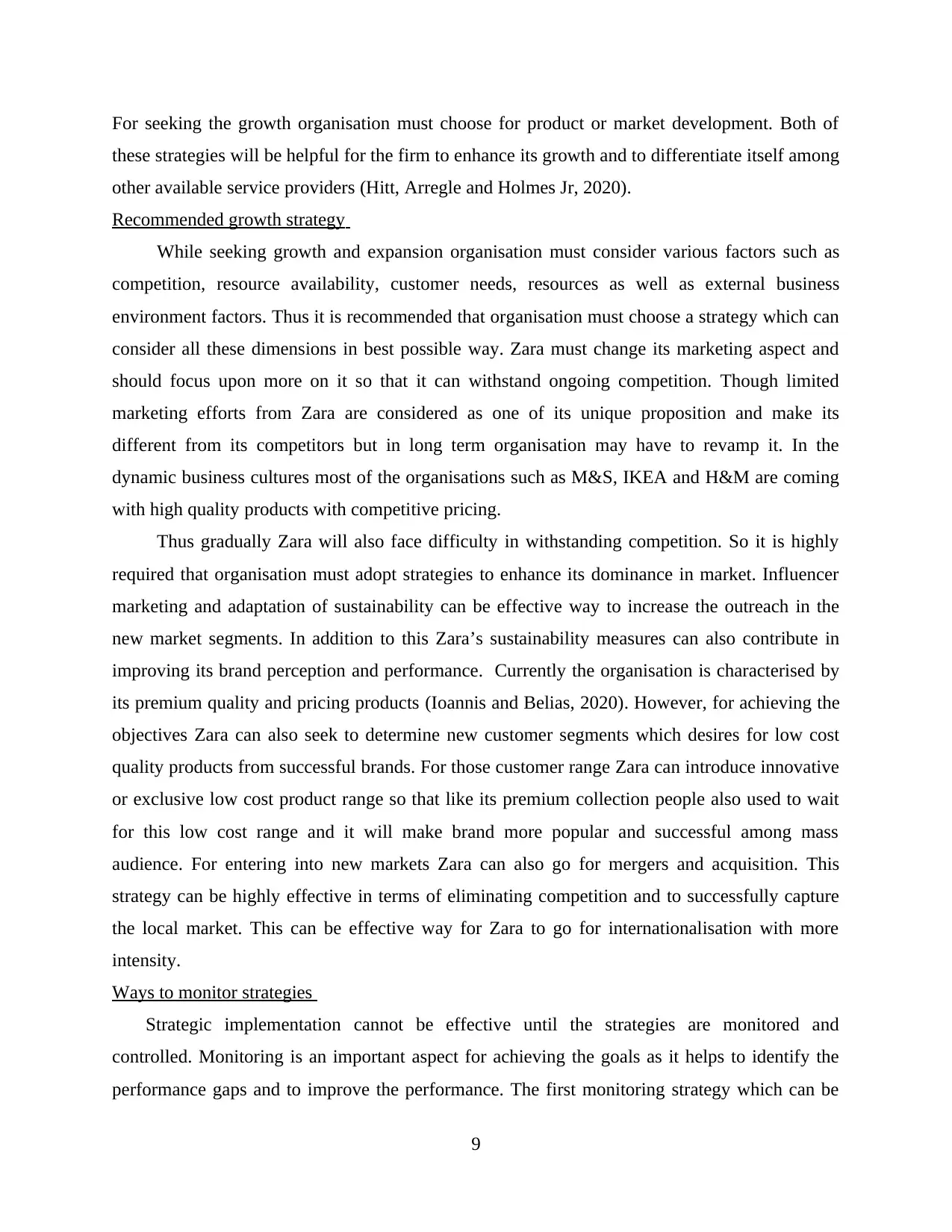
For seeking the growth organisation must choose for product or market development. Both of
these strategies will be helpful for the firm to enhance its growth and to differentiate itself among
other available service providers (Hitt, Arregle and Holmes Jr, 2020).
Recommended growth strategy
While seeking growth and expansion organisation must consider various factors such as
competition, resource availability, customer needs, resources as well as external business
environment factors. Thus it is recommended that organisation must choose a strategy which can
consider all these dimensions in best possible way. Zara must change its marketing aspect and
should focus upon more on it so that it can withstand ongoing competition. Though limited
marketing efforts from Zara are considered as one of its unique proposition and make its
different from its competitors but in long term organisation may have to revamp it. In the
dynamic business cultures most of the organisations such as M&S, IKEA and H&M are coming
with high quality products with competitive pricing.
Thus gradually Zara will also face difficulty in withstanding competition. So it is highly
required that organisation must adopt strategies to enhance its dominance in market. Influencer
marketing and adaptation of sustainability can be effective way to increase the outreach in the
new market segments. In addition to this Zara’s sustainability measures can also contribute in
improving its brand perception and performance. Currently the organisation is characterised by
its premium quality and pricing products (Ioannis and Belias, 2020). However, for achieving the
objectives Zara can also seek to determine new customer segments which desires for low cost
quality products from successful brands. For those customer range Zara can introduce innovative
or exclusive low cost product range so that like its premium collection people also used to wait
for this low cost range and it will make brand more popular and successful among mass
audience. For entering into new markets Zara can also go for mergers and acquisition. This
strategy can be highly effective in terms of eliminating competition and to successfully capture
the local market. This can be effective way for Zara to go for internationalisation with more
intensity.
Ways to monitor strategies
Strategic implementation cannot be effective until the strategies are monitored and
controlled. Monitoring is an important aspect for achieving the goals as it helps to identify the
performance gaps and to improve the performance. The first monitoring strategy which can be
9
these strategies will be helpful for the firm to enhance its growth and to differentiate itself among
other available service providers (Hitt, Arregle and Holmes Jr, 2020).
Recommended growth strategy
While seeking growth and expansion organisation must consider various factors such as
competition, resource availability, customer needs, resources as well as external business
environment factors. Thus it is recommended that organisation must choose a strategy which can
consider all these dimensions in best possible way. Zara must change its marketing aspect and
should focus upon more on it so that it can withstand ongoing competition. Though limited
marketing efforts from Zara are considered as one of its unique proposition and make its
different from its competitors but in long term organisation may have to revamp it. In the
dynamic business cultures most of the organisations such as M&S, IKEA and H&M are coming
with high quality products with competitive pricing.
Thus gradually Zara will also face difficulty in withstanding competition. So it is highly
required that organisation must adopt strategies to enhance its dominance in market. Influencer
marketing and adaptation of sustainability can be effective way to increase the outreach in the
new market segments. In addition to this Zara’s sustainability measures can also contribute in
improving its brand perception and performance. Currently the organisation is characterised by
its premium quality and pricing products (Ioannis and Belias, 2020). However, for achieving the
objectives Zara can also seek to determine new customer segments which desires for low cost
quality products from successful brands. For those customer range Zara can introduce innovative
or exclusive low cost product range so that like its premium collection people also used to wait
for this low cost range and it will make brand more popular and successful among mass
audience. For entering into new markets Zara can also go for mergers and acquisition. This
strategy can be highly effective in terms of eliminating competition and to successfully capture
the local market. This can be effective way for Zara to go for internationalisation with more
intensity.
Ways to monitor strategies
Strategic implementation cannot be effective until the strategies are monitored and
controlled. Monitoring is an important aspect for achieving the goals as it helps to identify the
performance gaps and to improve the performance. The first monitoring strategy which can be
9
⊘ This is a preview!⊘
Do you want full access?
Subscribe today to unlock all pages.

Trusted by 1+ million students worldwide
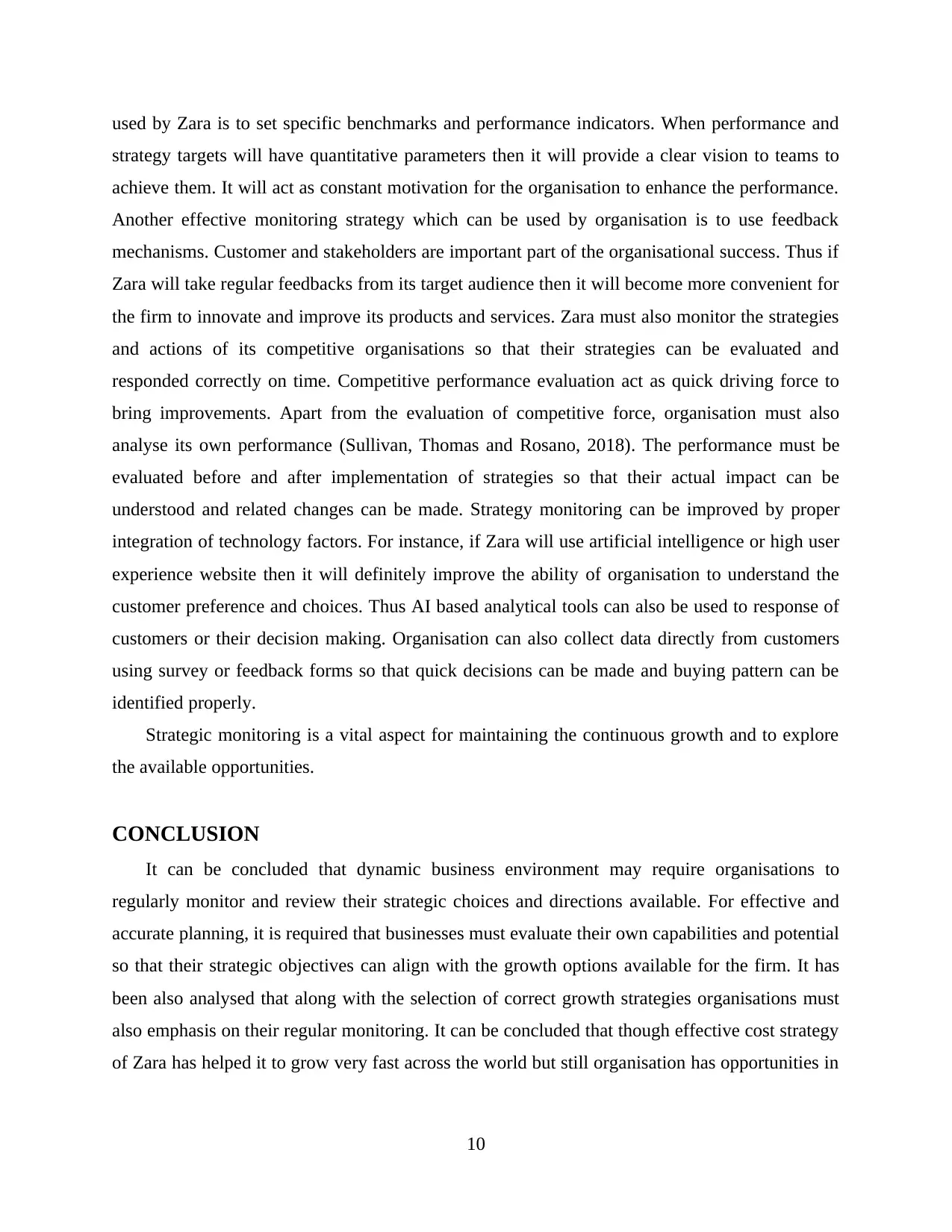
used by Zara is to set specific benchmarks and performance indicators. When performance and
strategy targets will have quantitative parameters then it will provide a clear vision to teams to
achieve them. It will act as constant motivation for the organisation to enhance the performance.
Another effective monitoring strategy which can be used by organisation is to use feedback
mechanisms. Customer and stakeholders are important part of the organisational success. Thus if
Zara will take regular feedbacks from its target audience then it will become more convenient for
the firm to innovate and improve its products and services. Zara must also monitor the strategies
and actions of its competitive organisations so that their strategies can be evaluated and
responded correctly on time. Competitive performance evaluation act as quick driving force to
bring improvements. Apart from the evaluation of competitive force, organisation must also
analyse its own performance (Sullivan, Thomas and Rosano, 2018). The performance must be
evaluated before and after implementation of strategies so that their actual impact can be
understood and related changes can be made. Strategy monitoring can be improved by proper
integration of technology factors. For instance, if Zara will use artificial intelligence or high user
experience website then it will definitely improve the ability of organisation to understand the
customer preference and choices. Thus AI based analytical tools can also be used to response of
customers or their decision making. Organisation can also collect data directly from customers
using survey or feedback forms so that quick decisions can be made and buying pattern can be
identified properly.
Strategic monitoring is a vital aspect for maintaining the continuous growth and to explore
the available opportunities.
CONCLUSION
It can be concluded that dynamic business environment may require organisations to
regularly monitor and review their strategic choices and directions available. For effective and
accurate planning, it is required that businesses must evaluate their own capabilities and potential
so that their strategic objectives can align with the growth options available for the firm. It has
been also analysed that along with the selection of correct growth strategies organisations must
also emphasis on their regular monitoring. It can be concluded that though effective cost strategy
of Zara has helped it to grow very fast across the world but still organisation has opportunities in
10
strategy targets will have quantitative parameters then it will provide a clear vision to teams to
achieve them. It will act as constant motivation for the organisation to enhance the performance.
Another effective monitoring strategy which can be used by organisation is to use feedback
mechanisms. Customer and stakeholders are important part of the organisational success. Thus if
Zara will take regular feedbacks from its target audience then it will become more convenient for
the firm to innovate and improve its products and services. Zara must also monitor the strategies
and actions of its competitive organisations so that their strategies can be evaluated and
responded correctly on time. Competitive performance evaluation act as quick driving force to
bring improvements. Apart from the evaluation of competitive force, organisation must also
analyse its own performance (Sullivan, Thomas and Rosano, 2018). The performance must be
evaluated before and after implementation of strategies so that their actual impact can be
understood and related changes can be made. Strategy monitoring can be improved by proper
integration of technology factors. For instance, if Zara will use artificial intelligence or high user
experience website then it will definitely improve the ability of organisation to understand the
customer preference and choices. Thus AI based analytical tools can also be used to response of
customers or their decision making. Organisation can also collect data directly from customers
using survey or feedback forms so that quick decisions can be made and buying pattern can be
identified properly.
Strategic monitoring is a vital aspect for maintaining the continuous growth and to explore
the available opportunities.
CONCLUSION
It can be concluded that dynamic business environment may require organisations to
regularly monitor and review their strategic choices and directions available. For effective and
accurate planning, it is required that businesses must evaluate their own capabilities and potential
so that their strategic objectives can align with the growth options available for the firm. It has
been also analysed that along with the selection of correct growth strategies organisations must
also emphasis on their regular monitoring. It can be concluded that though effective cost strategy
of Zara has helped it to grow very fast across the world but still organisation has opportunities in
10
Paraphrase This Document
Need a fresh take? Get an instant paraphrase of this document with our AI Paraphraser
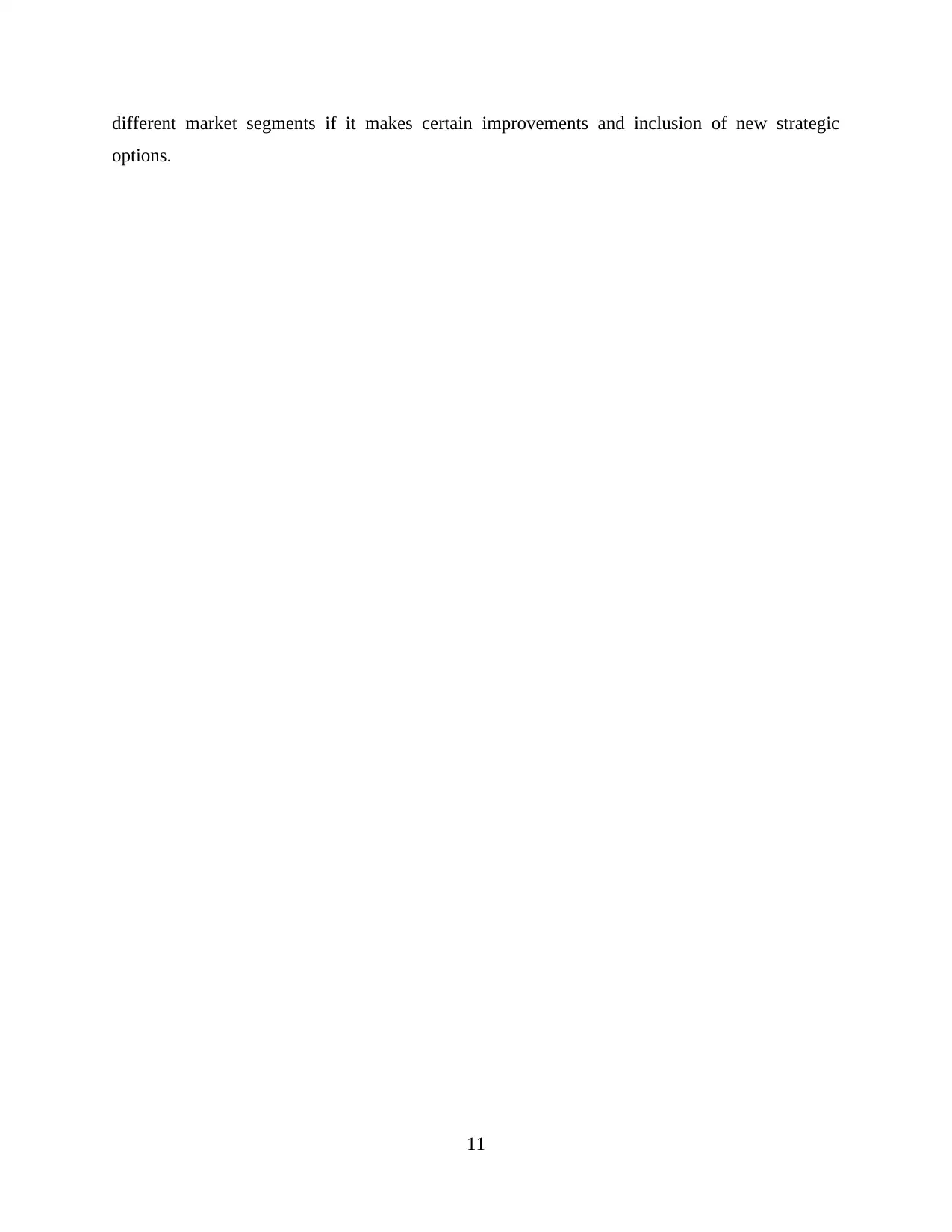
different market segments if it makes certain improvements and inclusion of new strategic
options.
11
options.
11
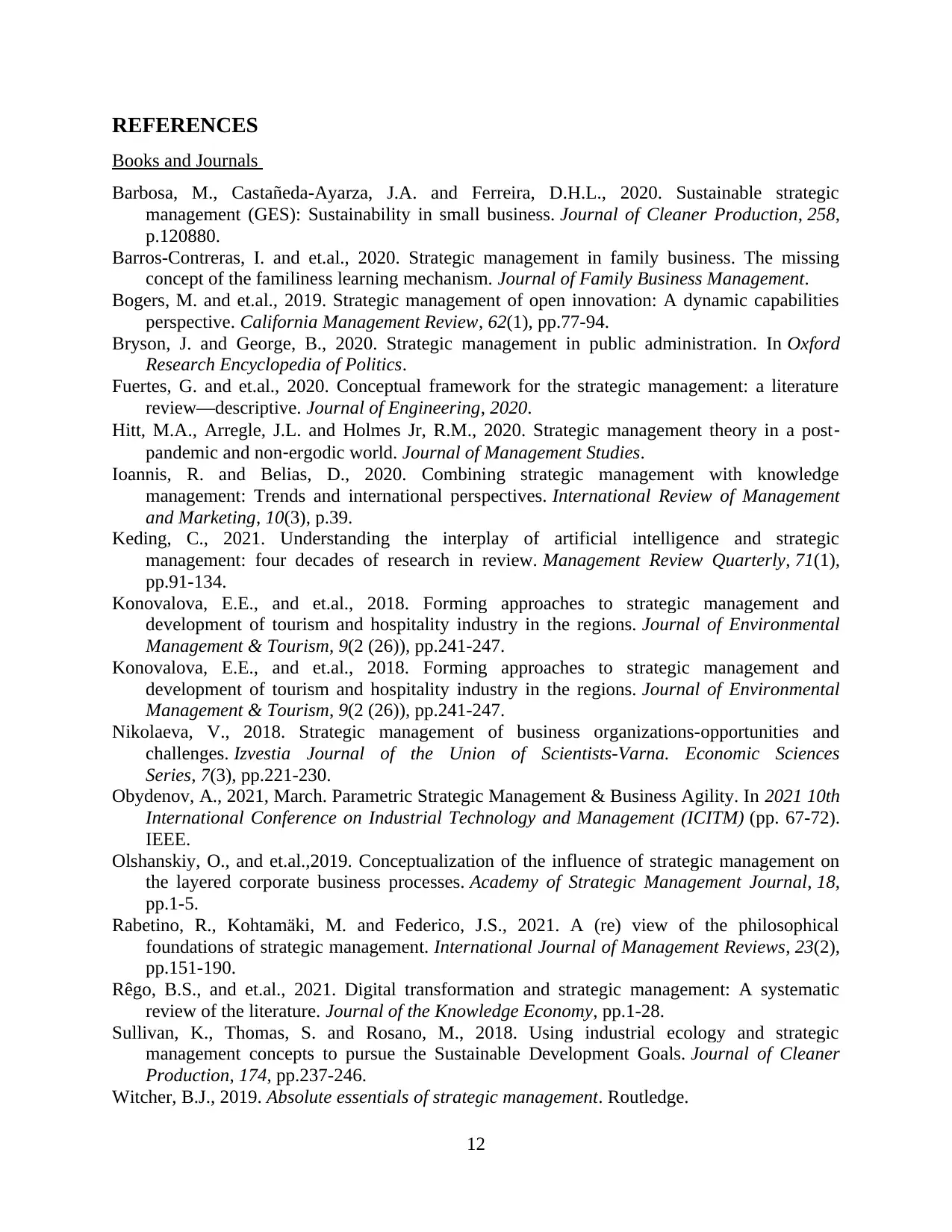
REFERENCES
Books and Journals
Barbosa, M., Castañeda-Ayarza, J.A. and Ferreira, D.H.L., 2020. Sustainable strategic
management (GES): Sustainability in small business. Journal of Cleaner Production, 258,
p.120880.
Barros-Contreras, I. and et.al., 2020. Strategic management in family business. The missing
concept of the familiness learning mechanism. Journal of Family Business Management.
Bogers, M. and et.al., 2019. Strategic management of open innovation: A dynamic capabilities
perspective. California Management Review, 62(1), pp.77-94.
Bryson, J. and George, B., 2020. Strategic management in public administration. In Oxford
Research Encyclopedia of Politics.
Fuertes, G. and et.al., 2020. Conceptual framework for the strategic management: a literature
review—descriptive. Journal of Engineering, 2020.
Hitt, M.A., Arregle, J.L. and Holmes Jr, R.M., 2020. Strategic management theory in a post‐
pandemic and non‐ergodic world. Journal of Management Studies.
Ioannis, R. and Belias, D., 2020. Combining strategic management with knowledge
management: Trends and international perspectives. International Review of Management
and Marketing, 10(3), p.39.
Keding, C., 2021. Understanding the interplay of artificial intelligence and strategic
management: four decades of research in review. Management Review Quarterly, 71(1),
pp.91-134.
Konovalova, E.E., and et.al., 2018. Forming approaches to strategic management and
development of tourism and hospitality industry in the regions. Journal of Environmental
Management & Tourism, 9(2 (26)), pp.241-247.
Konovalova, E.E., and et.al., 2018. Forming approaches to strategic management and
development of tourism and hospitality industry in the regions. Journal of Environmental
Management & Tourism, 9(2 (26)), pp.241-247.
Nikolaeva, V., 2018. Strategic management of business organizations-opportunities and
challenges. Izvestia Journal of the Union of Scientists-Varna. Economic Sciences
Series, 7(3), pp.221-230.
Obydenov, A., 2021, March. Parametric Strategic Management & Business Agility. In 2021 10th
International Conference on Industrial Technology and Management (ICITM) (pp. 67-72).
IEEE.
Olshanskiy, O., and et.al.,2019. Conceptualization of the influence of strategic management on
the layered corporate business processes. Academy of Strategic Management Journal, 18,
pp.1-5.
Rabetino, R., Kohtamäki, M. and Federico, J.S., 2021. A (re) view of the philosophical
foundations of strategic management. International Journal of Management Reviews, 23(2),
pp.151-190.
Rêgo, B.S., and et.al., 2021. Digital transformation and strategic management: A systematic
review of the literature. Journal of the Knowledge Economy, pp.1-28.
Sullivan, K., Thomas, S. and Rosano, M., 2018. Using industrial ecology and strategic
management concepts to pursue the Sustainable Development Goals. Journal of Cleaner
Production, 174, pp.237-246.
Witcher, B.J., 2019. Absolute essentials of strategic management. Routledge.
12
Books and Journals
Barbosa, M., Castañeda-Ayarza, J.A. and Ferreira, D.H.L., 2020. Sustainable strategic
management (GES): Sustainability in small business. Journal of Cleaner Production, 258,
p.120880.
Barros-Contreras, I. and et.al., 2020. Strategic management in family business. The missing
concept of the familiness learning mechanism. Journal of Family Business Management.
Bogers, M. and et.al., 2019. Strategic management of open innovation: A dynamic capabilities
perspective. California Management Review, 62(1), pp.77-94.
Bryson, J. and George, B., 2020. Strategic management in public administration. In Oxford
Research Encyclopedia of Politics.
Fuertes, G. and et.al., 2020. Conceptual framework for the strategic management: a literature
review—descriptive. Journal of Engineering, 2020.
Hitt, M.A., Arregle, J.L. and Holmes Jr, R.M., 2020. Strategic management theory in a post‐
pandemic and non‐ergodic world. Journal of Management Studies.
Ioannis, R. and Belias, D., 2020. Combining strategic management with knowledge
management: Trends and international perspectives. International Review of Management
and Marketing, 10(3), p.39.
Keding, C., 2021. Understanding the interplay of artificial intelligence and strategic
management: four decades of research in review. Management Review Quarterly, 71(1),
pp.91-134.
Konovalova, E.E., and et.al., 2018. Forming approaches to strategic management and
development of tourism and hospitality industry in the regions. Journal of Environmental
Management & Tourism, 9(2 (26)), pp.241-247.
Konovalova, E.E., and et.al., 2018. Forming approaches to strategic management and
development of tourism and hospitality industry in the regions. Journal of Environmental
Management & Tourism, 9(2 (26)), pp.241-247.
Nikolaeva, V., 2018. Strategic management of business organizations-opportunities and
challenges. Izvestia Journal of the Union of Scientists-Varna. Economic Sciences
Series, 7(3), pp.221-230.
Obydenov, A., 2021, March. Parametric Strategic Management & Business Agility. In 2021 10th
International Conference on Industrial Technology and Management (ICITM) (pp. 67-72).
IEEE.
Olshanskiy, O., and et.al.,2019. Conceptualization of the influence of strategic management on
the layered corporate business processes. Academy of Strategic Management Journal, 18,
pp.1-5.
Rabetino, R., Kohtamäki, M. and Federico, J.S., 2021. A (re) view of the philosophical
foundations of strategic management. International Journal of Management Reviews, 23(2),
pp.151-190.
Rêgo, B.S., and et.al., 2021. Digital transformation and strategic management: A systematic
review of the literature. Journal of the Knowledge Economy, pp.1-28.
Sullivan, K., Thomas, S. and Rosano, M., 2018. Using industrial ecology and strategic
management concepts to pursue the Sustainable Development Goals. Journal of Cleaner
Production, 174, pp.237-246.
Witcher, B.J., 2019. Absolute essentials of strategic management. Routledge.
12
⊘ This is a preview!⊘
Do you want full access?
Subscribe today to unlock all pages.

Trusted by 1+ million students worldwide
1 out of 13
Related Documents
Your All-in-One AI-Powered Toolkit for Academic Success.
+13062052269
info@desklib.com
Available 24*7 on WhatsApp / Email
![[object Object]](/_next/static/media/star-bottom.7253800d.svg)
Unlock your academic potential
Copyright © 2020–2025 A2Z Services. All Rights Reserved. Developed and managed by ZUCOL.




